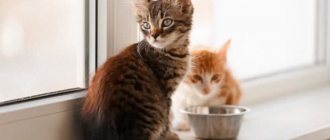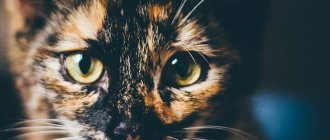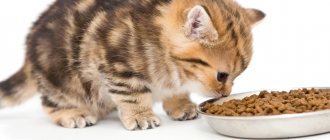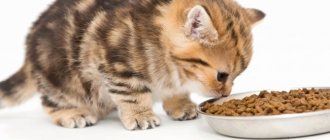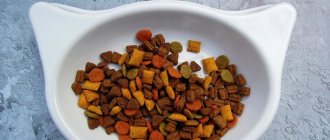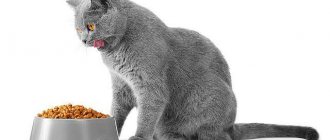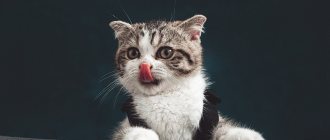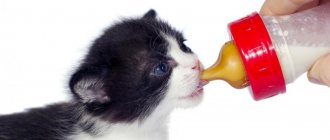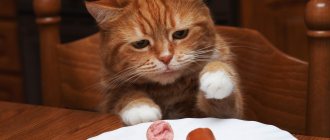Diet is important to keep your pets healthy. In apartment conditions, they are prone to obesity, so owners have to control the animals’ weight. Some owners do not notice how they constantly give pieces of food. You need to know how many times a day to feed your cat and what criteria should be taken into account.
Making a diet for a kitten
Every cat lover will be very happy and immensely happy when a little furry friend - a kitten - appears in his home. This cute ball of fur will make anyone smile even on the stormiest day, will always give its owner a piece of his enthusiasm and infect him with positivity.
A small pet already has its own character and habits, but it still requires attention and education. And in order for a tiny organism to grow and develop properly, it is necessary to take care of the optimal diet for it.
How to feed a newborn kitten without a cat
There are very sad cases when a mother cat dies after giving birth or a similar force majeure occurs. And if there is no other cat or even a small dog nearby that can feed the babies, then the person will have to take care of feeding the orphaned kittens on their own.
Kittens age from 0 to 10 days
In the first ten days after the baby is born, it should be fed with a special mixture, which is sold in veterinary stores. You can use a pipette, but a bottle would be preferable, because the baby needs to develop a sucking reflex.
Feeding should occur every two hours for the first three days, plus mandatory complementary feeding at night. Then you can feed every four hours.
For the first two weeks, the amount of the mixture should not exceed 30-40 ml per 100 grams of weight per day. Also, do not forget about a small amount of heated water.
And it is extremely undesirable to offer a kitten whole cow’s milk in the first month of life. A small stomach is not yet able to cope with such heavy food.
Kittens age from 10 to 30 days
You can prepare formula for your baby yourself without resorting to pet stores. This mixture should continue to be fed to the kitten until the age of 1 month. All proportions must be strictly observed. The opposite can lead to an upset stomach of the little one.
Recommendations for proportions:
- Cow's milk, preferably not from the store - 50 ml;
- Chicken yolk – 1/2 pcs.;
- Powdered milk – 15 g;
- Vegetable oil – 1 ml;
- Grape sugar – 4 g;
- Dry yeast – 2.5 g.
In extreme cases, you can use infant formula or diluted goat's milk.
It is important to remember that food must be heated to at least 30 degrees. Closer to the month, the amount of the mixture should be increased to 50-55 ml per 100 grams of weight per day.
Natural food (list of main important products):
From about three weeks of age and then closer to a month, you can start feeding the kitten food for adult animals. Many owners, as well as veterinarians, prefer natural food for small pets.
The kitten is from one month to two months old
At this age, the furry baby is already eating from a plate on his own. At 2 months, the daily portion size increases to 200 grams.
List of permitted products:
- Fresh meat broth;
- Puree of boiled vegetables;
- Children's cottage cheese without additives;
- Formula or milk;
- Boiled yolk 1 time per day (chicken or quail);
- Lean meat or fish (pre-shredded)
For now, it is recommended to grind all solid food for your baby in a blender.
The kitten is from two to three months old
At this age, a mustachioed pet needs to be fed at least 4 times a day. The daily requirement at 3 months increases to 300 grams.
List of permitted products:
- Boiled porridge in water;
- Lean beef or veal;
- Raw chicken or quail yolk;
- Kefir, low-fat sour cream or cream, fermented baked milk, biolact;
- Low-fat cottage cheese;
- Boiled chicken meat;
- Raw vegetables grated or mashed boiled;
- Boiled white fish.
Age - three months
From the age of three months, kittens need to gradually introduce solid food into their diet, because this is the time when babies' teeth change. The number of feedings is reduced to three times a day, and the daily food intake is increased to 360 grams.
List of permitted products:
- Porridge with milk or water;
- Lean raw and cooked meat;
- Raw and boiled fish fillet;
- Raw or scalded vegetables;
- Cottage cheese or yogurt without additives.
The kitten is three to four months old and older
The fluffy little ball has grown a little, plays actively and is interested in the world around him. Now he requires up to 75% meat on the menu.
Here are some rules to follow when feeding meat to small kittens:
- Under no circumstances should you give your kitten fresh meat. This is fraught with protein intoxication and subsequent seizures;
- It is worth excluding raw pork from your diet. It contains a huge number of parasites. There is also a high risk of contracting the fatal Aujeszky's disease (the so-called “false rabies”);
- To protect the kitten from viruses and parasites, raw meat must be heat treated or frozen in the freezer for three to four hours.
If the owner of a kitten who has already reached four months of age prefers natural food, you need to figure out what products, and most importantly, in what form to use in your pet’s diet.
List of main important products:
- Meat. Even after all the precautions taken, it is recommended to carry out antiparasitic prophylaxis in the animal;
- Bird. Most often, due to availability, chicken and turkey meat are used. This is a good option for a growing organism. True, for better digestion of food, it is advisable to pass pieces of meat through a meat grinder.
- Offal. Kidneys, stomachs, hearts and liver are a good source of protein for a growing body. And the liver is also useful for vitamin B12. But you shouldn’t get carried away with the liver; once or twice a week will be enough so as not to harm the small intestines;
- Cartilage and bones. Of course, it is useful to chew something for the development of teeth, but you need to be careful with bones. Even if you pass the bones through a meat grinder, sharp edges remain that can injure a fragile stomach;
- Fish. It is worth giving preference to marine inhabitants. Freshwater fish have less health benefits and more parasites;
- Cereals. Buckwheat and rice are the most suitable to add to the cat’s menu;
- Vegetables. Raw and cooked bring many benefits to the kitten’s digestion and are a source of essential vitamins.
Animal weight measurements
It is necessary to constantly weigh cats, especially kittens, to understand the correctness and completeness of their diet. Females often weigh less than males, and the weight of the animal depends very much on the breed. For example, in a year the British weigh from 4.5 to 7 kg, Maine Coons at the same age gain weight from 5.9 to 9 kg.
It is important to control your cat's weight from birth
However, the standard weight for most breeds of domestic cats is from 2.5 to 4.5 kilograms. If your cat's indicators go beyond these limits, you need to look for a different approach to feeding her. You may need to change food, increase or decrease the number of meals, and so on. Every animal, like every person, is unique. Therefore, the diet for him must be selected individually.
What is a kitten forbidden to eat?
To prevent ingredients harmful to its body from getting into the main menu of a small cat, you need to know the list of what you should not feed it:
- All foods with high fat content - whole cow's milk, cheese, butter, fatty fermented milk products;
- Floury, sweet, especially chocolate;
- Raw freshwater fish;
- Corn, millet and especially semolina porridge;
- Sausage, frankfurters, anything that contains a lot of salt and spices;
- Raw pork;
- Legumes and potatoes are poorly digestible by the stomach;
- Fast food.
Any veterinarian will also advise not to feed your pet economy class food. They have no benefit for kittens.
How many times a day should you feed your cat?
Today there are a huge number of food options for cats of any type, size and age. Experienced breeders and veterinarians recommend various menu options for the full development of the cat’s body: from natural to premium dry and wet food.
Feeding your cat too much will make the cat overweight. A lack of nutrients will lead to depletion of the pet’s body. Both options will lead to a deterioration in the cat’s health and the development of chronic diseases, which, in turn, can lead to the early death of the pet.
To prevent this from happening, it is necessary to properly optimize the animal’s nutrition based on its individual characteristics.
Is it possible to give a cat dog food?
The digestion of cats and dogs is quite different, both in the length of the esophagus and in the enzymes produced to digest food. Therefore, dry dog food has significant differences from cat food. So, for example, in them:
- reduced protein content;
- high carbohydrate content and very little fat;
- low vitamin A content;
- Taurine, which is important for the cat’s body, is missing;
- high content of plant substances that the cat’s body cannot absorb.
Additionally, due to the size difference, dog food kibble is noticeably larger than dry cat food. And this feature can lead to dental problems and poor digestion of food.
It can be said that a one-time snack of dog food will not harm your cat. If the need arises, let it be puppy food. However, feeding your cat such food all the time is prohibited! This will inevitably lead to gastrointestinal diseases.
Feeding standards by age
Every owner of a furry pet is interested not only in what to feed the cat, but also how many times a day it should be done. There is no definite answer to this question, because everything depends, as already mentioned, on the individual characteristics of each individual. The feeding norm for a domestic British cat that does not go outside differs from the diet of a mongrel cat living in a cottage and having access to nature.
The daily feeding rate for cats depends primarily on the age of the animal. Small kittens up to three months old should eat little and often. Starting from the age of three months, the furry baby is transferred to three meals a day. From about 5 months, closer to six months and until reaching the age of 1 year, you can gradually transfer your pet to two meals a day.
An adult cat, regardless of the type of feeding, should eat 2 times a day. This is the optimal diet for adults, recommended by most veterinarians.
Cats over 10 years of age are considered seniors. Their physical activity decreases, their appetite becomes unimportant. In this case, it is worth recommending that the animal be switched back to three meals a day, gradually reducing the volume of single servings.
How to make a cat's diet
A cat's diet is primarily influenced by the age and health of the cat. But nutrition also depends on the type of diet that the owner prepares for her. There are three most common options:
– regular food from the table;
– natural food;
– dry or wet store food.
You should not feed your cat from the table, because many “human” foods are very harmful to the animal. The cat's body suffers from many foods that humans usually consume: salty, fried, sweet.
Food from the common table is harmful for cats
Natural foods, especially when properly prepared, provide a good balance of essential nutrients. However, preparing such food takes much longer and can be significantly more expensive than other options. The cat's diet should include meat products (beef/veal or minced beef, chicken meat, chicken by-products, lamb, turkey), eggs and liver, porridge (rice and buckwheat), fermented milk products, bran bread, vegetables (for example, cauliflower). cabbage and beets). Every day, a little of everything or alternating days.
Natural food is most beneficial if it is varied
Industrially produced food, as a rule, contains all the vitamins and microelements necessary for the animal to saturate the body. But you should pay attention to the composition, because... Cheap food often uses dyes and flavor enhancers that are harmful to cats. Observe the shelf life. Dry diets are edible for 12 to 18 months. They do not need to be put in the refrigerator, but at the same time they are afraid of direct sunlight, heating devices and high humidity. Bags of dry food should be kept sealed to prevent them from losing their odor. Wet food is sealed and sterilized, so it lasts longer—up to two years—and doesn't need to be refrigerated. The cat is by nature a predator and does not eat carrion, so it prefers food at room temperature.
Store-bought food is perfectly balanced and saves the owner time
Calorie content
According to the established norm, one kilogram of an adult cat’s weight per day should not exceed 70 kcal. The easiest way to monitor caloric intake is when your pet receives commercial food. You can easily find all the necessary information on the packaging. It will be a little more difficult with a natural menu, because then the owner has to count calories on his own.
Counting calories - controlling your pet's weight
Daily weight
The weight of food that a cat should eat per day depends on exactly how much the animal weighs. For every kilogram of body weight there should be from thirty to sixty grams of feed. With a high caloric content of food, thirty grams per kilogram of weight is enough. If the nutritional value is low, the weight of the feed can be increased to sixty grams per kilogram of animal body weight.
Water mode
Water is one of the key nutrients. Especially for cats that eat dry food. Lack of fluid can lead to serious problems. Dry food in a humid environment gets wet and swells, filling the stomach, therefore, the cat needs less food. Of course, absolutely all cats need water, regardless of the type of diet. To do this, be sure to have a container of water next to the bowl of food.
Water is important and necessary for a cat
It is necessary to replace the water every day, as cats love to drink fresh. It is better to give soft water with a low mineral content, which is very important for a cat, given its tendency to urolithiasis. The animal drinks about 9-10 times a day, but little by little.
When choosing a drinker, pay attention to the material from which it is made. It is very likely that your cat will not drink from a plastic saucer because this material absorbs and retains unpleasant odors. It is better to buy a glass, ceramic or porcelain bowl with the same bottom and surface area with a volume of approximately 200 ml.
Dry food feeding standards
How much dry food a mustachioed pet should eat per day is determined based on its age, weight and certain physical characteristics. The average daily requirement for a healthy active cat is 250 – 300 grams. Many food packages have calculations given for different weights and ages of cats, but these are also average data for healthy individuals of average weight, and they may not be suitable, for example, for a neutered cat or a pregnant cat.
Many owners are interested in what kind of food is best to feed their pet: dry food, wet food from bags, or give preference to natural food. For example, what is better to feed a nursing, pregnant, sterilized or neutered cat?
It makes no big difference what type of food to feed the animal, as long as the diet is properly balanced.
Artificial breeds, Scottish, British and others, as well as breeds prone to metabolic disorders, such as Sphynxes, are best fed with commercial dry food throughout their lives. The usual natural diet is not suitable for them; dry food is the most rationally balanced for these breeds.
To determine the food consumption for a particular cat, it is advisable to have it examined by a veterinarian and give his recommendations.
Feeding standards for wet food
Some breeders and veterinarians recommend following the following proportions when feeding a cat with industrial food: feed 2/3 of dry food to 1/3 of wet food. Feed should be purchased from one manufacturer.
Wet food is usually produced in canned form or in small bags (packs)
Do not forget that you cannot mix industrial food and natural food, as it is difficult for a cat’s stomach to adjust to new food.
If an adult cat has been eating natural food since childhood, it will take him at least two weeks to accustom his body to store-bought food.
Table
There are many options for distributing cat food depending on the age and weight of the cat. After all, there is a difference in how to feed a one-month-old kitten and, for example, an adult 7-year-old cat. Here is an approximate table for feeding a furry pet:
| Cat weight | Feeding rates depending on the type of food | ||
| Healthy eating | Nutrition for weight loss | For an older animal | |
| 2 kg | 40 g | — | 30 g |
| 3 kg | 45 g | — | 30 g |
| 4 kg | 60 g | — | 40 g |
| 5 kg | 75 g | 60 g | 60 g |
| 6 kg | 80 g | 60 g | 60 g |
| 8 kg | 105 g | 75 g | 90 g |
| 10 kg | 120 g | 80 g | 105 g |
But do not forget that these are generalized figures; only a competent veterinarian will select an individual healthy diet after carefully examining the animal.
Factors influencing diet
In addition to choosing food, the owner selects the number of meals suitable for the pet. To do this, several factors are taken into account.
Age
Young and adult animals eat differently. For example, kittens grow for 5-6 months and need to be fed 3 times a day. For adults, two meals are enough. Cats from 7-8 years old can be fed only once a day, this is due to a decrease in activity and a slowdown in metabolic processes.
Health
A sick animal requires a special diet, agreed upon with a veterinarian. Often a specialist selects individual nutrition. If the cat refuses to eat, first of all, the symptoms should be relieved and treated, after which the appetite will return.
Physical activity
Depending on the lifestyle the cat leads, the optimal diet is selected. For active ones, high-calorie food is suitable, and there can be two meals.
Adult sterilized pets leading a sedentary lifestyle are put on dietary food, a portion is given once a day. It is best to discuss feeding options with your veterinarian. We recommend reading the article about food for sterilized cats, where we provide a rating of the 10 best industrial foods of the premium, super-premium and holistic classes.
Floor
The amount of food and its calorie content also depend on gender. Males need an increased amount of calories, which means their portion should be larger than that of cats.
Reproductive condition
Pregnant females expend more energy, which means they require more calories, while spayed or neutered animals, on the contrary, are prone to obesity. This is due to the fact that after surgery, cats’ metabolism slows down and their daily calorie needs change.
Lactating cats also require a higher calorie diet because they expend a lot of energy feeding their babies. During this period, the number of meals increases, but portions should be small.
Breed
Each breed has its own characteristics, larger ones require more calories. Also, depending on temperament and metabolism, the optimal diet is selected, taking into account all the nuances (allergies, metabolic rate, etc.). It is best to discuss all these issues with your veterinarian.
Be sure to read the article about the composition of cat food.
Correct feeding process
When the owner of a four-legged mustache decides on the type and amount of food his pet needs, you can deal directly with the feeding process.
There are three main ways to feed adult cats:
- System of free access to food. Most often, such a system accompanies feeding dry food. After all, it can be left in the air for a long time and it will not deteriorate. Often the owner is away from home during the day and fills a large heaping bowl so that his pet “doesn’t go hungry.” As a result, the cat may eat the entire bowl at once, which, of course, will not have the best effect on his health.
- Restrictions on the amount of feed. This system is for cats prone to obesity. They calculate a certain amount of food that should be eaten at one meal, or use a special low-calorie food.
- Feeding time restrictions. This method streamlines the pet's daily routine. The cat is fed at a certain time, morning and evening. Even if the pet has not eaten all the food at one time, the bowl is removed until the next feeding.
There are now various electronic and automatic feeders available for different feeding methods for domestic cats. They are adjusted to a specific time and portion size. Pet stores have a large selection of such devices. And which bowl is more profitable to purchase, simple or automatic, is up to the owner of the furry pet to decide, depending on the circumstances of his life.
Now every loving owner has the necessary knowledge to choose the right diet for their domestic cat.
If the pet is active, plays happily and feels great, then its owner did everything right.
Useful tips
Among other things, you can give some more useful tips on feeding cats:
- If there are several pets in the house that require different diets, feed them separately from each other.
- Be sure to combine wet food with dry food - when chewed, it cleans the teeth of plaque.
- If in the summer heat your cat refuses to eat, but in the fall, on the contrary, eats with excessive appetite, this is normal. Don’t be alarmed, this is how the animal reacts to the changing seasons.
- Cat food should be stored like human food, i.e. observing all sanitary measures.
- Sometimes you can't be too strict. Observe which food your pet enjoys the most, and don’t be shy about pampering him.
- And one more prudent advice: do not start feeding the kitten from your table. To keep those big green eyes by your side for more than twenty years (this is a very realistic period for a pet), do not give him treats from your plate.
